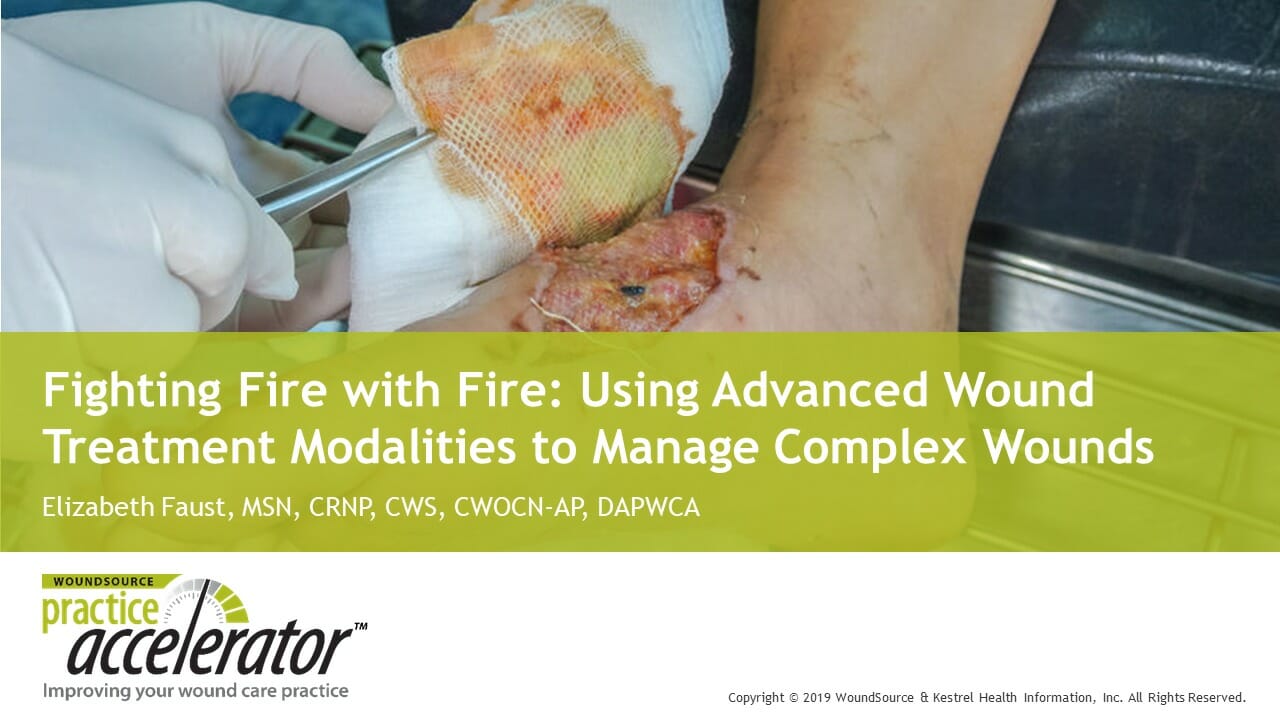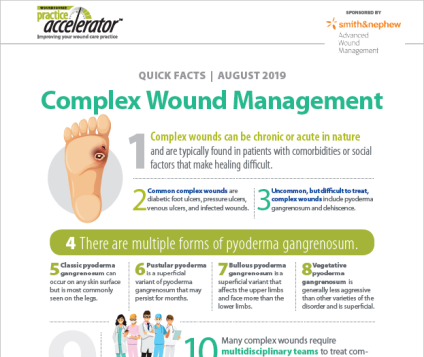
WoundSource Practice Accelerator: Complex Wound Management
AUGUST IS COMPLEX WOUND MANAGEMENT MONTH Complex wounds are wounds with one or more underlying factor that makes healing more difficult. As part of the WoundSource Practice Accelerator series, we are offering you this educational portal into a variety of topics related to complex wound management. Please scroll below to choose your learning experience and please share this page with your social network and colleagues. Expanded awareness leads to better prevention and care. WATCH VIDEO View this month’s educational
Upcoming Webinar
WoundSource Practice Accelerator: Complex Wound Management
AUGUST IS COMPLEX WOUND MANAGEMENT MONTH Complex wounds are wounds with one or more underlying factor that makes healing more difficult. As part of the WoundSource Practice Accelerator series, we are offering you this educational portal into a variety of topics related to complex wound management. Please scroll below to choose your learning experience and please share this page with your social network and colleagues. Expanded awareness leads to better prevention and care. WATCH VIDEO View this month’s educational resources. WEBINAR WHITE PAPER FACT SHEET QUIZ FEATURED ARTICLES ON-DEMAND WEBINAR Fighting Fire with Fire: Using Advanced Wound Treatment Modalities to Manage Complex Wounds Presenter: Elizabeth Faust, MSN, CRNP, CWS, CWOCN-AP, DAPWCA Complex wounds create a challenge to both the health care team and the patients and families that struggle with them. The amount of care required to overcome the complicating factors of these wounds creates a large economic and labor burden on the health care system. This webinar will provide a review of wound and patient treatment modalities and advanced wound care treatments that can be used to manage and promote healing in complex wounds. Participants will learn about advanced wound therapies that can help manage patients with a complex wound in the inpatient and outpatient setting. REGISTER NOW DOWNLOADABLE WHITE PAPER Simplifying the Complex: Best Practices for Managing Complex Wounds Complex wounds place a heavy burden on the health care system, in terms of both financial cost and patients' quality of life. Because these wounds are frequently misdiagnosed and incorrectly treated, simplifying the complex wound begins with an accurate diagnosis. This guide provides a clear overview of complex wounds and their diagnosis and management. DOWNLOAD THE WHITE PAPER DOWNLOADABLE FACT SHEET Quick Facts - Complex Wound Management Download Quick Facts – Complex Wound Management and share it within your facility. This two-page fact sheet was created to support staff education on on complex wound development, types of complex wounds and current best practice therapeutic modalities. The print-friendly format is perfect for posting on the bulletin board or distributing to your nursing staff at in-service. DOWNLOAD THE FACT SHEET SPONSORED BY: How Much Do You Know About Complex Wound Management? Take our 10-question quiz to find out! TAKE THE QUIZ Terms to Know: Complex Wound Management Caseous necrosis: Caseous necrosis is found in tuberculosis, syphilis, and some fungal diseases. It forms in response to intracellular pathogens, such as mycobacteria, and can also be found in association with granulomas. With this type of cell death, the tissue assumes a cheese-like appearance. Clostridium difficile: Also referred to C. diff, this bacterium can cause symptoms ranging from diarrhea to life-threatening inflammation of the colon. On a lesion, semihard nodules may be found, in which case lymph node tuberculosis may be present. VIEW THE FULL GLOSSARY READ THIS MONTH'S FEATURED ARTICLES Complex Wounds 101 Complex wounds pose a significant challenge for many health care providers. These wounds are often multifaceted, making treatment tremendously difficult. They represent a substantial burden on... Read More Complex Wounds: Common and Uncommon Although complex wounds typically present with clinical challenges in treatment, there are certain types of wounds that clinicians are used to facing: pressure wounds... Read More Biofilm Battles: Managing Chronic Infections Biofilm: this term is frequently used in the wound care space. Why does the bedside nurse or clinician need to know about this commonly used word, yet undertreated... Read More Factors Contributing to Complex Wounds A vast percentage of wounds become chronically stalled because of mixed etiology and other underlying comorbid medical conditions. This means the wound... Read More SPONSORED BY For over 150 years, Smith & Nephew has taken a pioneering approach to product design and services, helping to reduce the human and economic costs of wounds. AUGUST IS COMPLEX WOUND MANAGEMENT MONTH Complex Wound Management Complex wounds often require an interdisciplinary approach to manage underlying complicating factors. This can include disease management, infection treatment, psychosocial support, and others. Watch this brief overview video to learn more about multifaceted wound care and the educational resources made available on complex wound management during this month’s Practice Accelerator program.
White Paper
Simplifying the Complex: Best Practices for Managing Complex Wounds
Complex wounds place a heavy burden on the health care system, in terms of both financial cost and patients' quality of life. Because these wounds are frequently misdiagnosed and incorrectly treated, simplifying the complex wound begins with an accurate diagnosis. This extensively illustrated guide provides a clear overview of complex wounds and their diagnosis and management. Two real-world case studies of patients with baffling complex wounds showcase the sophisticated diagnostic and detective...Fact Sheet
Quick Facts - Diabetic Foot Ulcers
A diabetic foot ulcer (DFU) is an open sore commonly found on the bottom of the foot in patients with diabetes. This wound is typically caused by a combination of poor vascularity, neuropathy, and repetitive trauma. DFUs are all too frequent complications of diabetes, and they impose a heavy burden on patients and health care systems. The central goals of DFU management are achieving wound healing, addressing risk factors, achieving adequate perfusion, controlling infection and glucose levels...Featured Articles
Biofilm Battles: Managing Chronic Infections
By the WoundSource Editors Biofilm: this term is frequently used in the wound care space, but biofilm continues to be largely undertreated in wound care. What do the bedside nurse or clinician need to know about biofilm? Should clinicians care less about biofilm on a maintenance or palliative wou...
Read MoreFactors Contributing to Complex Wounds
By the WoundSource Editors A vast percentage of wounds become chronically stalled because of mixed etiology and other underlying comorbid medical conditions. This means the wound is multifactorial, and using a singular approach won’t be enough. Lower extremity wounds, for example, can have diabet...
Read MoreComplex Wounds: Common and Uncommon
By the WoundSource Editors Although complex wounds typically present with clinical challenges in treatment, there are certain types of wounds that clinicians are used to facing: pressure wounds , arterial wounds, venous wounds, diabetic wounds, moisture-related wounds, end-of-life wounds, dehisce...
Read MoreComplex Wounds 101
By the WoundSource Editors Complex wounds pose a significant challenge for many health care providers. These wounds are often multifaceted, making treatment tremendously difficult. They represent a substantial burden on the health care industry, with annual costs in North America alone estimated ...
Read MoreBiofilm Battles: Managing Chronic Infections
By the WoundSource Editors Biofilm: this term is frequently used in the wound care space, but biofilm continues to be largely undertreated in wound care. What do the bedside nurse or clinician need to know about biofilm? Should clinicians care less about biofilm on a maintenance or palliative wou...
Read MoreFactors Contributing to Complex Wounds
By the WoundSource Editors A vast percentage of wounds become chronically stalled because of mixed etiology and other underlying comorbid medical conditions. This means the wound is multifactorial, and using a singular approach won’t be enough. Lower extremity wounds, for example, can have diabet...
Read MoreComplex Wounds: Common and Uncommon
By the WoundSource Editors Although complex wounds typically present with clinical challenges in treatment, there are certain types of wounds that clinicians are used to facing: pressure wounds , arterial wounds, venous wounds, diabetic wounds, moisture-related wounds, end-of-life wounds, dehisce...
Read MoreComplex Wounds 101
By the WoundSource Editors Complex wounds pose a significant challenge for many health care providers. These wounds are often multifaceted, making treatment tremendously difficult. They represent a substantial burden on the health care industry, with annual costs in North America alone estimated ...
Read MoreBiofilm Battles: Managing Chronic Infections
By the WoundSource Editors Biofilm: this term is frequently used in the wound care space, but biofilm continues to be largely undertreated in wound care. What do the bedside nurse or clinician need to know about biofilm? Should clinicians care less about biofilm on a maintenance or palliative wou...
Read MoreFactors Contributing to Complex Wounds
By the WoundSource Editors A vast percentage of wounds become chronically stalled because of mixed etiology and other underlying comorbid medical conditions. This means the wound is multifactorial, and using a singular approach won’t be enough. Lower extremity wounds, for example, can have diabet...
Read MoreComplex Wounds: Common and Uncommon
By the WoundSource Editors Although complex wounds typically present with clinical challenges in treatment, there are certain types of wounds that clinicians are used to facing: pressure wounds , arterial wounds, venous wounds, diabetic wounds, moisture-related wounds, end-of-life wounds, dehisce...
Read MoreComplex Wounds 101
By the WoundSource Editors Complex wounds pose a significant challenge for many health care providers. These wounds are often multifaceted, making treatment tremendously difficult. They represent a substantial burden on the health care industry, with annual costs in North America alone estimated ...
Read More









